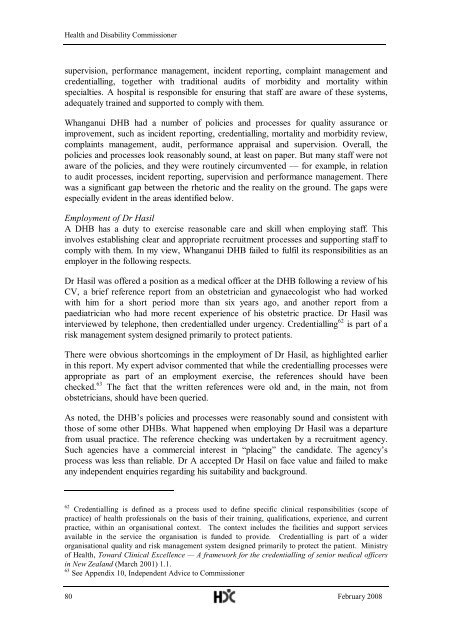Roman Hasil and the Whanganui DHB - Health and Disability ...
Roman Hasil and the Whanganui DHB - Health and Disability ...
Roman Hasil and the Whanganui DHB - Health and Disability ...
Create successful ePaper yourself
Turn your PDF publications into a flip-book with our unique Google optimized e-Paper software.
<strong>Health</strong> <strong>and</strong> <strong>Disability</strong> Commissioner<br />
supervision, performance management, incident reporting, complaint management <strong>and</strong><br />
credentialling, toge<strong>the</strong>r with traditional audits of morbidity <strong>and</strong> mortality within<br />
specialties. A hospital is responsible for ensuring that staff are aware of <strong>the</strong>se systems,<br />
adequately trained <strong>and</strong> supported to comply with <strong>the</strong>m.<br />
<strong>Whanganui</strong> <strong>DHB</strong> had a number of policies <strong>and</strong> processes for quality assurance or<br />
improvement, such as incident reporting, credentialling, mortality <strong>and</strong> morbidity review,<br />
complaints management, audit, performance appraisal <strong>and</strong> supervision. Overall, <strong>the</strong><br />
policies <strong>and</strong> processes look reasonably sound, at least on paper. But many staff were not<br />
aware of <strong>the</strong> policies, <strong>and</strong> <strong>the</strong>y were routinely circumvented — for example, in relation<br />
to audit processes, incident reporting, supervision <strong>and</strong> performance management. There<br />
was a significant gap between <strong>the</strong> rhetoric <strong>and</strong> <strong>the</strong> reality on <strong>the</strong> ground. The gaps were<br />
especially evident in <strong>the</strong> areas identified below.<br />
Employment of Dr <strong>Hasil</strong><br />
A <strong>DHB</strong> has a duty to exercise reasonable care <strong>and</strong> skill when employing staff. This<br />
involves establishing clear <strong>and</strong> appropriate recruitment processes <strong>and</strong> supporting staff to<br />
comply with <strong>the</strong>m. In my view, <strong>Whanganui</strong> <strong>DHB</strong> failed to fulfil its responsibilities as an<br />
employer in <strong>the</strong> following respects.<br />
Dr <strong>Hasil</strong> was offered a position as a medical officer at <strong>the</strong> <strong>DHB</strong> following a review of his<br />
CV, a brief reference report from an obstetrician <strong>and</strong> gynaecologist who had worked<br />
with him for a short period more than six years ago, <strong>and</strong> ano<strong>the</strong>r report from a<br />
paediatrician who had more recent experience of his obstetric practice. Dr <strong>Hasil</strong> was<br />
interviewed by telephone, <strong>the</strong>n credentialled under urgency. Credentialling 62 is part of a<br />
risk management system designed primarily to protect patients.<br />
There were obvious shortcomings in <strong>the</strong> employment of Dr <strong>Hasil</strong>, as highlighted earlier<br />
in this report. My expert advisor commented that while <strong>the</strong> credentialling processes were<br />
appropriate as part of an employment exercise, <strong>the</strong> references should have been<br />
checked. 63 The fact that <strong>the</strong> written references were old <strong>and</strong>, in <strong>the</strong> main, not from<br />
obstetricians, should have been queried.<br />
As noted, <strong>the</strong> <strong>DHB</strong>’s policies <strong>and</strong> processes were reasonably sound <strong>and</strong> consistent with<br />
those of some o<strong>the</strong>r <strong>DHB</strong>s. What happened when employing Dr <strong>Hasil</strong> was a departure<br />
from usual practice. The reference checking was undertaken by a recruitment agency.<br />
Such agencies have a commercial interest in “placing” <strong>the</strong> c<strong>and</strong>idate. The agency’s<br />
process was less than reliable. Dr A accepted Dr <strong>Hasil</strong> on face value <strong>and</strong> failed to make<br />
any independent enquiries regarding his suitability <strong>and</strong> background.<br />
62 Credentialling is defined as a process used to define specific clinical responsibilities (scope of<br />
practice) of health professionals on <strong>the</strong> basis of <strong>the</strong>ir training, qualifications, experience, <strong>and</strong> current<br />
practice, within an organisational context. The context includes <strong>the</strong> facilities <strong>and</strong> support services<br />
available in <strong>the</strong> service <strong>the</strong> organisation is funded to provide. Credentialling is part of a wider<br />
organisational quality <strong>and</strong> risk management system designed primarily to protect <strong>the</strong> patient. Ministry<br />
of <strong>Health</strong>, Toward Clinical Excellence — A framework for <strong>the</strong> credentialling of senior medical officers<br />
in New Zeal<strong>and</strong> (March 2001) 1.1.<br />
63 See Appendix 10, Independent Advice to Commissioner<br />
80 February 2008

















